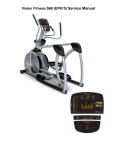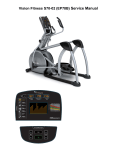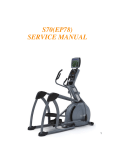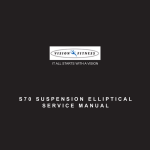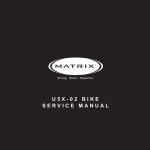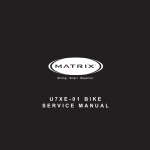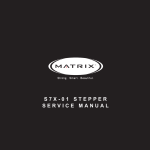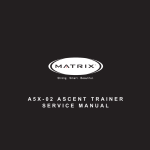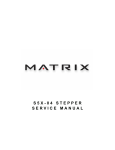Download Vision Fitness U70 Service manual
Transcript
Vision Fitness U70-02 (CB68C) Service Manual TABLE OF CONTENTS CHAPTER 1: MAINTENANCE PROCEDURE 1.1 Preventive Maintenance Schedule…………………………………………………………..4 1.2 Cleaning the Grooves………………………………………...............................................5 CHAPTER 2: WIRING DIAGRAM INSTRUCTION 2.1 Electrical Installation…………………………………………………………………….…....6 2.2 Electrical Diagram…………………………….………………………………………….…...7 2.3 Wiring Diagram……………………………………………………………………………......8 2.4 2.5 Lower Control Board Wiring Diagram………………….………………………….………...8 Console Wiring Diagram……………………………………………………………………...9 CHAPTER 3: ENGINEERING MODE 3.1 Using Engineering Mode...............................................................................................11 CHAPTER 4: TROUBLESHOOTING 4.1 Console Error Codes………………………………………………………………………….12 4.2 4.3 4.4 4.5 Troubleshooting – No Display on the Console or the Display is Dim..………………….13 Troubleshooting – No RPM is Displayed During the Exercise………………..…….…....14 Troubleshooting – All or Some of the Function Keys Do Not Respond………….......….15 Troubleshooting – High or No Resistance…………………………………………..…...…16 4.6 4.7 4.8 Troubleshooting – Pedals Slipping…………………………………….…………..……..….17 Troubleshooting – Knocking or Creaking Noise………….……………………………...…17 Troubleshooting – Heart Rate Function Does Not Work or is Reading Incorrectly……..18 CHAPTER 5: PART REPLACEMENT GUIDE 5.1 Console Replacement.....................................................................................................19 5.2 Heart Rate Handlebar Replacement ..............................................................................20 5.3 Heart Rate Grip Replacement ........................................................................................21 5.4 5.5 5.6 5.7 Cup Holder Replacement................................................................................................22 Seat Pad Replacement...................................................................................................23 Back Pad Replacement..................................................................................................24 Seat Post Replacement..................................................................................................25 5.8 5.9 5.10 5.11 Seat Post Insert Replacement........................................................................................26 Pedal Replacement........................................................................................................27 Crank Removal…...........................................................................................................28 Shrouds Removal...........................................................................................................28 5.12 Lower Control Board Replacement ...............................................................................29 5.13 Drive Belt Replacement..................................................................................................31 2 CHAPTER 5: PART REPLACEMENT GUIDE 5.14 Idler Set Replacement....................................................................................................32 5.15 Generator Belt Replacement..........................................................................................33 5.16 5.17 5.18 5.19 Generator Replacement.................................................................................................35 Transmission Axle Set Replacement .............................................................................37 Pulley Axle Set Replacement.........................................................................................39 Rear Stabilizer Replacement......................................................................................…42 5.20 Testing the Bike......................................................................................................... …43 CHAPTER 6: SOFTWARE UPGRADE PROCEDURE 6.1 Software Upgrade Instructions…....................................................................................44 3 CHAPTER 1: MAINTENANCE PROCEDURE 1.1 Preventive Maintenance Schedule PREVENTIVE MAINTENANCE SCHEDULE Item Daily Weekly Monthly Quarterly Biannual Console Mounting Bolts Inspect Frame Inspect Display Console Clean Inspect Seat Guide Rods Clean Lubricate Pedals Clean Inspect Handlebar Clean Handrail & Handlebar Clean Belt Grooves V Belt Annual Inspect Inspect Inspect Clean Inspect 4 CHAPTER 1: MAINTENANCE PROCEDURE 1.2 Cleaning the Grooves If there is any dust in the grooves of the Poly-V belts and pulleys, noises will be generated during operation. Frequency: Every 3 to 4 months. [Procedure]: 1. Remove the Poly-V belts (450-JFG) and check the grooves of the belt for dirt or dust and clean if any is present. 2. Check the grooves in the pulley for dirt or dust and clean if any is present. 3. Check the grooves in the roller pulley for dirt or dust and clean if any is present. 5 CHAPTER 2: WIRING DIAGRAM INSTRUCTION\ 2.1 Electrical Installation 6 CHAPTER 2: WIRING DIAGRAM INSTRUCTION\ 2.2 Electrical Diagram 7 CHAPTER 2: WIRING DIAGRAM INSTRUCTION\ 2.3 Wiring Diagram P01- CONSOLE WIRE 2.4 Lower Control Board Diagram J2 J3 J4 J2 7 pin terminal to the console J3 3 pin terminal to the generator J4 2 pin terminal to the power resistor 8 CHAPTER 2: WIRING DIAGRAM INSTRUCTION\ 2.5 Console Wiring Diagram Select switch JQK – Quick key for S70 JQK1 – Quick key for R70 JHD – Console digital wire for S70 JAI – Console wire for S60, U/R 70 JHG1, JHG2 – Hang grip Port JQK JQK1 JHD JAI JHG1/JHG2 Select switch Function Quick key cable for S70 Quick key cable for R70 Console wire for S70 Console wire for S60, U70, R70 Hand grip cable for all models Select current model by hand 9 CHAPTER 3: ENGINEERING MODE 3.1 Using Engineering Mode 1. Press & Hold both UP and DOWN RESISTANCE keys at the same time for 3-5 second to enter Engineering Mode as shown in Figure A. The display will show “P1 MAX TIME” as shown in Figure B. 2. To scroll through the list of options in Engineering Mode, use the UP and DOWN RESISTANCE keys. 3. Press the ENTER key to see the value of the function. 4. To change the value of the setting, use the UP and DOWN RESISTANCE keys. 5. To confirm and save the value of the setting, press the ENTER key. 6. Press and hold the START key for 3-5 seconds to return to normal operation. FIGURE A FIGURE B KEY NAME FUNCTION UP Select function or adjust value DOWN Select function or adjust value ENTER Enter the function item START Save value or quit mode Hold “ START” key 3’s System reset Hold “ UP&DOWN” key 3’s Enter engineering mode 10 CHAPTER 3: ENGINEERING MODE 3.1 Using Engineering Mode – Continued CUSTOMSETTING DEFAULT MINIMUM MAXIMUM DESCRIPTION MAX TIME 99 min 5 min 99 min Set a maximum workout time USER TIME 60 min 5 min 99 min Set a default workout time DF AGE 40 10 100 Set a default age for all programs DF LEVEL 1 1 20 Set a default resistance level for all programs DF GENDER MALE FEMALE MALE Set a default gender for all programs UNIT MILE KM MILE Set the unit to miles or kilometers MACHINE BIKE BIKE _ _ _ Total time the product has been used in hours. _ _ _ Total distance the product has been used. DISPLAY TEST - - - MACHINE TEST _ _ _ KEYPAD TEST _ _ _ VERSION - - - ACCUMULATED TIME ACCUMULATED DISTANCE LANGUAGE ELLIPTICAL Set machine to bike or elliptical mode Used by service technicians to test LED displays Provides a way to test heart rate and resistance without entering a program. Provides a way to test the keypads for function. Display Current software version The native language prompts in the instruction center 11 CHAPTER 4: TROUBLESHOOTING 4.1 Console Error Codes Error Messages on the Console Code Class 0x0441 B Description Solution When UCB implements a command, LCB has not Check the console cable connection, replace the LCB. received this command. Power resistor is short circuited (over 4A), or the current 0x01AC C Check the connection of power resistor or replace power resistor is over 3.7A for 1 second. 0x02AB C Machine Type Error Set the Machine Type to the correct type of LCB 0x02B3 C Resistance Type Error Set the Machine Type to the correct type of LCB 0x04A0 C The LCB has no message returned to the UCB for over Check the console cable connections, replace the LCB / UCB as needed. 3 seconds. 0x0201 A LCB Battery Low Voltage Check battery recharge function or replace new battery 0x0248 B Battery disconnection or fail. Check the connection of battery or replace new battery 12 CHAPTER 4: TROUBLESHOOTING 4.2 Troubleshooting – No Display on the Console or the Display is Dim NO DISPLAY ON THE CONSOLE OR THE DISPLAY IS DIM POSSIBLE CAUSES: 1. The console is damaged or the console cable is not connected properly. 2. Poor connection to all the terminals on the control board. 3. The lower control board is damaged. 4. The generator is damaged. SOLUTION: 1. Check the connection of the console cable at the UCB. 2. Remove the console cable from the J5 socket on the console. Pedal the machine and set your multi-meter to DC voltage and place both terminals on pins 1 & 4 of the console cable. There should be a reading of more than 5.5VDC (Figure A). - If voltage is more than 5.5VDC, replace the console. - If voltage is less than 5.5VDC, or the new console does not resolve the issue, replace the console cable. 3. Open the rear shrouds then check if all the wire harnesses are connected properly to the terminals of the LCB. 4. Unplug the generator cable from the control board, pedal the machine and set your multi-meter to AC voltage and place both terminals on pins 1 & 2, pins 2 & 3, and pins 3 & 1 of the console cable to check if the voltage is variable (Figure B). - If the voltage reading shown is variable (varies based on RPM), replace the LCB. - If the voltage reading shown is not variable, replace the generator. FIGURE A FIGURE B 13 CHAPTER 4: TROUBLESHOOTING 4.3 Troubleshooting – No RPM is Displayed During the Exercise NO RPM IS DISPLAYED DURING THE EXERCISE POSSIBLE CAUSES: 1. The console is damaged or the console cable is not connected properly. 2. Poor connection to all the terminals on the lower control board. 3. The lower control board is damaged. 4. The generator is damaged. SOLUTION: 1. Check the connection of the console cable at the UCB. 2. Remove the console cable from the J5 socket on the console. Pedal the machine and set your multi-meter to resistance and place a terminal on pin 3 of the console cable at both the LCB and UCB. There should be a resistance (ohm) reading (Figures A & B). - If a resistance reading is shown, replace the console. - If the there is no resistance reading, or a new console does not resolve the issue, replace the console cable. 3. Open the rear shrouds and check if all the wire harnesses are connected properly to the terminals of the LCB. 4. Unplug the generator cable from the LCB and pedal the machine to check if the voltage is variable. - If a variable voltage reading is shown (varies based on RPM), replace the LCB. - If the voltage reading shown is not variable, replace the generator. FIGURE A FIGURE B 14 CHAPTER 4: TROUBLESHOOTING 4.4 Troubleshooting – All or Some of the Function Keys Do Not Respond ALL OR SOME OF THE FUNCTION KEYS DO NOT RESPOND POSSIBLE CAUSES: 1) The keypad connection ribbon cable has not been plugged in correctly. 2) The keypad is damaged. 3) The UCB is damaged. SOLUTION: 1) Check the connections of the keypad at the UCB. a. Remove the console from the console mast. b. Remove the 6 screws holding the back of the console to the front (Figure A). c. Inspect the keypad ribbon cable connection at the UCB (Figure B). d. Even if the keypad ribbon cable appears to be connected correctly, unplug and reseat the cable, then retest. 2) Replace the affected keypad. 3) Replace the UCB. FIGURE A FIGURE B 15 CHAPTER 4: TROUBLESHOOTING 4.5 Troubleshooting – High or No Resistance HIGH OR NO RESISTANCE POSSIBLE CAUSES: 1) The console is damaged or the console cable is not connected properly. 2) The console cable is damaged. 3) The power resistor is damaged. 4) The LCB is damaged. 5) The generator is damaged. SOLUTION: 1) Check the console cable connections at the UCB and LCB. 2) Remove the rear shrouds and check if the console cable is connected properly to the LCB. 3) Set your multi-meter to resistance (ohms) and place both terminals on the power resistor wires .Check the power resistor wires for resistance (Figure A). -If the power resistor wire does not have resistance, replace the power resistor. 4) Unplug the generator cable from the LCB. Pedal the machine and set your multi-meter to AC voltage and place both terminals on pins 1 & 2, pins 2 & 3, and pins 3 & 1 of the console cable to check if the voltage is variable (Figure B). - If a variable voltage reading is shown (varies based on RPM), replace the LCB. - If the voltage reading shown is not variable, replace the generator. FIGURE A FIGURE B 16 CHAPTER 4: TROUBLESHOOTING 4.6 Troubleshooting – Pedals Slipping PEDALS SLIPPING POSSIBLE CAUSES: 1) The belt tension is not high enough. 2) The one way bearing is damaged. SOLUTION: 1) Remove the covers and check the belt tension. a. Tighten the drive belt tension if needed by moving the spring tension clip to another hole. b. The generator belt should be tightened to 85 ft / lbs. 2) If the belts are tensioned correctly and the pedals are still slipping, the one way bearing is damaged, replace the drive assembly. 4.7 Troubleshooting – Knocking or Creaking Noise KNOCKING OR CREAKING NOISE POSSIBLE CAUSES: 1) The pedal is on the crank too loosely. 2) The crank or axle is worn out. 3) The belt tension is not high enough, or the belts are too dirty. SOLUTION: 1) Tighten the pedal on the crank. 2) Tighten the crank on the drive axle. Replace the crank or axle as needed. 3) Remove the covers and check the belt tension. a. Tighten the drive belt tension if needed by moving the spring tension clip to another hole (see Section 5.17). b. The generator belt should be tightened to 85 ft / lbs. 4) Clean the belts. If they are worn or will not clean, replace the belts. 17 CHAPTER 4: TROUBLESHOOTING 4.8 Troubleshooting – Heart Rate Function Does Not Work or is Reading Incorrectly HEART RATE FUNCTION DOES NOT WORK OR IS READING INCORRECTLY POSSIBLE CAUSES: 1) The heart rate grips are not connected properly or are defective. 2) The heart rate grip wiring is damaged or not connected correctly. 3) The HR board is damaged. 4) The UCB is damaged. SOLUTION: 1) With a multi-meter set for DC voltage, place one terminal on each of the HR grip plates. The HR grip should give a voltage reading of between 0.5 and 2.0VDC. a. If the voltage is not between 0.5 and 2.0VDC, remove the 3 screws holding the HR grip together and check the connection of the HR grip wiring. 2) Check continuity of the HR grip wiring. a. Place one terminal of a multi-meter set for resistance on the HR grip wiring at the HR grip, and the other terminal on the HR grip wiring at the console. An ohm reading of around 1 should be expected. If the reading is higher than 1, replace the HR grip wiring. 3) Remove the console. Remove the 6 screws holding the front of the console to the rear. Check the connection of the HR board wiring to the UCB. a. If all the wiring is intact and has good contact, replace the HR board. 4) If the HR board, HR grips, and HR grip wiring do not solve the issue, replace the UCB. 18 CHAPTER 5: PART REPLACEMENT GUIDE 5.1 Console Replacement 1) Remove the 4 screws holding the console to the frame (Figure A). FIGURE A 2) Disconnect the console cable and HR connections from the defective console and remove the console (Figure B). FIGURE B 3) Reinstall the wire connections to the new console. 4) Carefully push the wires into the console and mast until they are clear of the console / mast connection and attach the console to the mast using the 4 screws. 5) Test the bike for function as outlined in Section 5.20. 19 CHAPTER 5: PART REPLACEMENT GUIDE 5.2 Heart Rate Handlebar Replacement 1) Remove the 4 screws holding the heart rate handlebar to the console mast being careful to support the handlebar (Figure A). FIGURE A 2) Carefully pull the wires from the console mast until the connectors are showing, and then disconnect the 3 wires from the handlebar and remove the defective handlebar (Figure B). FIGURE B 3) Reverse Steps 1-2 to install a new handlebar. 4) Test the bike for function as outlined in Section 5.20. 20 CHAPTER 5: PART REPLACEMENT GUIDE 5.3 Heart Rate Grips Replacement 1) Remove the 2 screws holding the HR grip together (Figure A). 2) Once the 3 screws are removed, the HR grip can be split into 2 pieces (Figure B). FIGURE A FIGURE B 3) Disconnect the HR plate wiring and remove the old HR grip (Figure C). 4) Reverse Steps 1-3 to install new HR grips. The white wire should be on the bottom side HR plate, the red wire on the upside. Make sure that the end cap also gets installed (Figure D). FIGURE C FIGURE D 5) Test the Bike for function as outlined in Section 5.20. 21 CHAPTER 5: PART REPLACEMENT GUIDE 5.4 Cup Holder Replacement 1) Remove the 2 screws holding the cup holder to the console mast (Figure A). FIGURE A 2) Remove the cup holder (Figure B). FIGURE B 3) Reverse Steps 1-2 to install a new cup holder. 22 CHAPTER 5: PART REPLACEMENT GUIDE 5.5 Console Mast Replacement 1) Remove the console as outlined in Section 5.1. 2) Remove the HR handlebars as outlined in Section 5.2. 3) Lift up the rubber boot at the bottom of the console mast (Figure A), and remove the 5 screws holding the console mast to the frame (Figure B). FIGURE A FIGURE B 4) Pull the wires out the bottom of the console mast and remove the mast (Figure C). FIGURE C 5) When installing a new console mast, be sure to pull the console wires up through the new mast prior to installing the 5 screws removed in Step 3 into the frame. 6) Test the bike for function as outlined in Section 5.20. 23 CHAPTER 5: PART REPLACEMENT GUIDE 5.6 Seat Pad Replacement 1) Remove the 3 screws holding the seat pad to the seat post (Figure A). FIGURE A 2) Lift the seat pad away from the seat post (Figure B). FIGURE B 3) Reverse Steps 1-2 to install a new seat pad. 24 CHAPTER 5: PART REPLACEMENT GUIDE 5.7 Seat Post Replacement 1) Remove the seat adjustment pin (Figure A). 2) Pull the seat post upward until the stem comes away from the frame and set it aside (Figure B). FIGURE A FIGURE B 3) Remove the 3 screws holding the seat pad to the seat post (Figure C). FIGURE C 4) Reverse Steps 1-3 to install a new seat post. 25 CHAPTER 5: PART REPLACEMENT GUIDE 5.8 Seat Post Insert Replacement 1) Remove the seat adjustment pin (Figure A). 2) Pull the seat post upward until the stem comes away from the frame and set it aside (Figure B). FIGURE A FIGURE B 3) Remove the rubber boot that rests at the bottom of the seat post (Figure C). 4) Grab the lip of the seat post insert and remove it from the seat post (Figure D). FIGURE C FIGURE D 5) Reverse Steps 1-4 to install a new seat post insert. 26 CHAPTER 5: PART REPLACEMENT GUIDE 5.9 Pedal Replacement 1) Use a 15 mm pedal wrench to remove the pedal from the crank (Figure A). NOTE: For the right side pedal, the threads are normal. For the left side pedal, the threads are reversed (the pedal turns off counterclockwise). 2) Remove the pedal (Figure B). FIGURE A FIGURE B 3) Reverse Steps 1-2 to install a new pedal. 27 CHAPTER 5: PART REPLACEMENT GUIDE 5.10 Crank Removal NOTE: A special tool is needed to correctly replace a crank. Order part: # 022696-00 from Vision Customer Tech Support. 1) Assemble the special tool as shown in Figure A. The two sides are different on the tool. 2) Remove the crank arm cover (Figure B). #1 #2 Tool number: 022696-00 Figure A Figure B 3) Attach the #1 side of the tool into the crank and use a wrench to remove the nut from the crank (Figure C). 4) Thread the #2 side of tool into the crank. Then turn it at least 7 full revolutions until it is close into the crank (Figure D). #1 FIGURE C #2 FIGURE D 5) Turn the #1 side of the tool to pull off the crank (Figures E & F). FIGURE E FIGURE F 28 CHAPTER 5: PART REPLACEMENT GUIDE 5.11 Shrouds Removal 1) Remove the crank as outlined in Section 5.10. 2) Remove the seat adjustment pin (Figure A). 3) Remove the seat post and seat post boot (Figures B & C). FIGURE A FIGURE B FIGURE C 4) Remove the 11 screws holding the left shroud in place (Figure D). 5) Remove the 11 screws holding the right shroud in place (Figure E). FIGURE D FIGURE E 6) Once the screws are removed from both side shrouds, lift the shrouds away from the frame. 7) Reverse Steps 1-6 to install a new shroud. 29 CHAPTER 5: PART REPLACEMENT GUIDE 5.12 Lower Control Board Replacement 1) Remove the shrouds as outlined in Section 5.11. 2) Disconnect the 3 wire connections to the lower board (Figure A). 3) Remove the 2 screws holding the lower board to the frame (Figure B), and remove the lower control board. FIGURE A FIGURE B 4) Reverse Steps 1-3 to install a new lower board. Figure C shows the connections at the board. J2 J3 J4 J2 7 pin terminal to the console J3 3 pin terminal to the generator J4 2 pin terminal to the power resistor FIGURE C 5) Test the bike for function as outlined in Section 5.20. 30 CHAPTER 5: PART REPLACEMENT GUIDE 5.13 Drive Belt Replacement 1) Remove the right side shroud as outlined in Section 5.11. 2) Pull up on the tension assembly and walk the belt off of the pulley (Figure A). 3) Remove the drive belt (Figure B). FIGURE A FIGURE B 4) Reverse Steps 1-3 to install a new drive belt. NOTE: Be sure to reattach the tension spring (Figure C). If more tension is needed on the drive belt, multiple holes are available for the lower spring attachment (Figure C). FIGURE C 5) Test the bike for function as outlined in Section 5.20. 31 CHAPTER 5: PART REPLACEMENT GUIDE 5.14 Idler Set Replacement 1) Remove the shrouds as outlined in Section 5.11. 2) The Idler set is attached to the frame with one bolt (Figure A) with nut (Figure B). FIGURE A FIGURE B 3) Remove the tension spring (Figure C). 4) Remove the Idler set (Figure D). FIGURE C FIGURE D 5) Reverse Steps 1-4 to install a new Idler set. NOTE: Torque the bolt removed in Step 4 to 30 N-m. 6) Test the bike for function as outlined in Section 5.20. 32 CHAPTER 5: PART REPLACEMENT GUIDE 5.15 Generator Belt Replacement 1) Remove the shrouds as outlined in Section 5.11. 2) Remove the cable ties on the wire connector of the generator and unplug the generator wire from the LCB (Figure A). 3) Remove the nuts holding the generator to the frame (Figure B). FIGURE A FIGURE B 4) Remove the nuts putting tension on the generator belt (Figure C). 5) Remove the small screw at the right side of frame that keeps the generator from spinning freely (Figure D). FIGURE C FIGURE D 33 CHAPTER 5: PART REPLACEMENT GUIDE 5.15 Generator Belt Replacement – Continued 6) Remove the generator belt (Figure E). 7) Pull the generator out of the frame towards the front of the unit, and remove the generator belt (Figure F). FIGURE E FIGURE F 8) Reverse Steps 1-7 to install a new generator belt. NOTE: Be sure to re-tension the new generator belt to 80 ft / lbs of torque. 9) Test the bike for function as outlined in Section 5.20. 34 CHAPTER 5: PART REPLACEMENT GUIDE 5.16 Generator Replacement 1) Remove the shrouds as outlined in Section 5.11. 2) Remove the cable ties on the wire connector of the generator and unplug the generator wire from the LCB (Figure A). 3) Remove the nuts holding the generator to the frame (Figure B). FIGURE A FIGURE B 4) Remove the nuts putting tension on the generator belt (Figure C). 5) Remove the small screw at the right side of frame that keeps the generator from spinning freely (Figure D). FIGURE C FIGURE D 35 CHAPTER 5: PART REPLACEMENT GUIDE 5.16 Generator Replacement – Continued 6) Remove the generator belt (Figure E). 7) Pull the generator out of the frame towards the front of the unit, and remove the generator belt (Figure F). FIGURE E FIGURE F 8) Reverse Steps 1-7 to install a new generator. NOTE: Be sure to re-tension the new generator belt to 80 ft / lbs of torque. 9) Test the bike for function as outlined in Section 5.20. 36 CHAPTER 5: PART REPLACEMENT GUIDE 5.17 Pulley Axle (Secondary) Set Replacement 1) Remove the shrouds as outlined in Section 5.11. 2) Remove the drive belt and generator belt from the pulleys by hand (Figure A). 3) Remove the screw holding the bearing to the pulley axle on the right side of the frame (Figures B & C). FIGURE A FIGURE B 4) Turn the pulley until the hole in the pulley lines up with the screw in the frame. Then remove the first screw (Figure D). FIGURE C FIGURE D 5) Turn the pulley until the hole in the pulley lines up with the screw in the frame. Then remove the second screw (Figure E). 6) Turn the pulley until the hole in the pulley lines up with the screw in the frame. Then remove the third screw (Figure F). FIGURE E FIGURE F 37 CHAPTER 5: PART REPLACEMENT GUIDE 5.17 Pulley Axle (Secondary) Set Replacement – Continued 7) Install a screw into the secondary axle and turn the screw until the head is close to the secondary axle. Use a mallet to hit the screw until the pulley axle assembly is loose in the frame and remove it (Figures G & H). FIGURE G FIGURE H 8) Reverse Steps 1-7 to install a new pulley axle set. NOTE: The bearings on the pulley axle cannot be re-used after removal of the pulley axle assembly. NOTE: Clean the bearing frame housing and daub a fixative (Red Loctite 603 is recommended) on the inside of housing in the frame prior to installation of a new pulley axle set (Figures I & J). NOTE: Torque the screw removed in Step 5 to 20 N-m. Please daub with fixative (LT-603) on the inside of housing. \ FIGURE I FIGURE J 9) Test the bike for function as outlined in Section 5.20. 38 CHAPTER 5: PART REPLACEMENT GUIDE 5.18 Drive Axle Set Replacement 1) Remove the shrouds as outlined in Section 5.11. 2) Pull up on the tension assembly and walk the drive belt off of the pulley (Figure A). 3) Remove the drive belt (Figure B). FIGURE A FIGURE B 4) Remove the c-clip holding the bearing in place on the left side of the frame (Figures C & D). FIGURE C FIGURE D 39 CHAPTER 5: PART REPLACEMENT GUIDE 5.18 Drive Axle Set Replacement – Continued 5) Install two nuts into the pulley axle and turn the nuts until the heads are close to the drive axle (Figures E & F). FIGURE E FIGURE F 6) Use a mallet to hit the pulley axle until it is loose in the frame and remove it (Figures G & H). FIGURE G FIGURE H 40 CHAPTER 5: PART REPLACEMENT GUIDE 5.18 Drive Axle Set Replacement – Continued 7) Use a mallet with a punch to hit the remained bearing until it is removed from frame (Figure I & J). FIGURE I FIGURE J 8) Reverse Steps 1-7 to install a new drive axle set. NOTE: The bearings on the drive axle cannot be re-used after removal of the drive axle assembly. NOTE: Clean the bearing frame housing and daub a fixative (Red Loctite 603 is recommended) on the inside of housing in the frame prior to installation of a new drive axle set (Figures K & L). NOTE: Torque the screw removed in Step 5 to 20 N-m. Please daub with fixative (LT-603) on the inside of housing. FIGURE K FIGURE L 9) Test the bike for function as outlined in Section 5.20. 41 CHAPTER 5: PART REPLACEMENT GUIDE 5.19 Rear Stabilizer Replacement 1) Lean the bike to one side and remove the 4 screws holding the rear stabilizer to the frame (Figure A). 2) Remove the rear stabilizer (Figure B). FIGURE A FIGURE B 3) Reverse Steps 1-2 to install a rear stabilizer. 42 CHAPTER 5: PART REPLACEMENT GUIDE 5.20 Testing the Bike ONCE THE UNIT OR REPLACEMENT PART IS FULLY INSTALLED AND ASSEMBLED AND PROPERLY PLACED ON THE FLOOR, USE THE FOLLOWING INSTRUCTIONS TO SETUP AND TEST THE MACHINE: 1) Check that the console is set for bike. a. Press & Hold both UP and DOWN RESISTANCE keys until Engineering Mode appears on the display. b. Use the UP or DOWN RESISTANCE keys to scroll to Machine Type. c. Press GO on Machine Type and make sure it is set for Bike. d. If Machine Type is not set for Bike, change to Bike using the UP or DOWN RESISTANCE keys and press STOP to save. e. Press and hold the STOP key for 3-5 seconds to return to normal function. 2) Without hitting start or entering any program modes, sit on the bike and hold the handlebars while pedaling to simulate exercising. While moving, listen for any odd noises or squeaks. 3) After stopping movement, press the green GO key and begin pedaling. 4) Grasp the hand grips to check for proper heart rate response. 5) Press the level up and down buttons on the console and hand grips to make sure resistance is fully functional. 6) If everything functions properly, stop pedaling and the unit will reset to normal operation within 30 seconds. 43 CHAPTER 6: SOFTWARE UPGRADE PROCEDURE 6.1 Software Upgrade Instructions A. Service Tools & Accessories: 1. MSP-FET430 Gang Programmer 2. Parts number: MT00L-039 3. Software A B A: 14 PIN B: POWER SUPPLY SPECIFICATION: 8~15V 300MA MSP-FET430 TOOLS 44 CHAPTER 6: SOFTWARE UPGRADE PROCEDURE 6.1 Software Upgrade Instructions – Continued B. VISION U70 BIKE SOFTWARE UPGRADE PROCEDURE 1. Connect the MSP-GANG430 hardware, PC, and console as shown in Figure A. FIGURE A 2. Click on the GANG430 icon located in the program group specified during installation of the software (the default group is ADT430). The MSP430 FLASH Gang Programmer GUI is displayed on the screen as shown in Figure B. FIGURE B The status message in the GUI displays the message "MSP-GANG430 Gang Programmer connected." If this message is not displayed, check the COM Port selection in the communication settings of PC and the MSP-GANG430 connections. 3. Follow sequence 3.1 - 3.8 to setup the parameter as shown in Figure C. 3.1 Select the H/W Self Test function on the maintenance menu. 3.2 Selects the PC serial port used to communicate with the MSP-GANG430. 45 CHAPTER 6: SOFTWARE UPGRADE PROCEDURE 6.1 Software Upgrade Instructions – Continued 3.3 Select the required device using the Device Type menu. 3.4 Select the console software file to be programmed into the MSP-GANG430 using the File Name menu. The format supported for the console software file is TI TXT (.txt). 3.5 Use the Load Image button to download the console software file to the MSP-GANG430 as shown in Figure A. 3.6 Select the supply voltage for the console from MSP-GANG430. 3.7 Select the options in Main Process as required. 3.8 When you install the first console, please connect MSP-GANG430 with computer. Click on the Start button in the Main Process section to start the console install. The progress and completion of the operation are displayed in the Status section. 3.8 3.7 3.6 3.4 3.3 3.5 3.2 3.1 FIGURE C 46 CHAPTER 6: SOFTWARE UPGRADE PROCEDURE 6.1 Software Upgrade Instructions – Continued 4. After the first console is installed, you can remove the RS232 cable from PC to MSP-GANG430 as shown in Figure D. Connect the other consoles being installed to MSP-GANG430 as shown in Figure E. Press the MSP430 “START” button, the “MODE” LED will to glitter about 10 sec, if the install passes, the OK green LED will light as shown in Figure F. 1. Press “START” button. Remove the RS232 cable . FIGURE D FIGURE E 3. If the console install passes, the OK green LED will light. 2. The “MODE”LED will glitter after about 10 sec when console be installed from MSP-GANG430. FIGURE F 5. Install the console onto frame. Then pedal the machine to provide power for the console. Enter into Engineering Mode to confirm if the software has been installed / upgraded and confirm if the machine type is right. 6. Test the bike for function as outlined in Section 5.20. 47















































